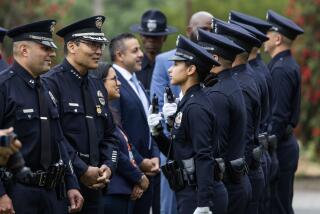For Police, ‘It Is the Routine That Kills You’ : Training: After three killings, officers are grimly reminded that they were instructed as recruits to keep their guard up, even in everyday situations.
- Share via
After the third killing of a police officer in Southern California in two weeks, Compton Patrolman Jack McConnell recalled a line that a training officer told him 23 years ago when he was a young recruit at the police academy: “It is the routine that kills you.”
It was a routine traffic stop that resulted in the death of a Garden Grove policeman early Tuesday morning after he pulled over a motorcyclist. Another apparently routine traffic stop proved fatal to two Compton police officers, who were shot execution-style Feb. 22 after they pulled over a red pickup truck.
“The routine can kill you because it’s something you do over and over again and maybe you’re not as cautious and maybe you let your guard down,” McConnell said. “That’s something you’ve got to fight every day.”
And now, he said, the streets are becoming so violent and guns are so prevalent that even that routine has become fraught with great danger. Any random street encounter, McConnell said, has the potential to be a highly charged, gut-wrenching confrontation.
While the number of police officers killed in the line of duty nationally has decreased over the years, the “streets are still more violent today,” said Bernie Dryden, supervisor of the FBI statistical unit that tracks police killings. In 1992, 55 law enforcement officers were killed, down from 92 in 1982, and 117 in 1972, according to FBI figures.
Better training, the advent of SWAT teams and other specialized units, and the increased use of bulletproof vests and semiautomatic weapons by police officers have contributed to the decline in fatal shootings. But assaults against police officers are up, and every type of street crime is on the rise, said Gerald Arenberg, director of the National Assn. of Chiefs of Police.
Twenty-five years ago, when Arenberg was a young patrolman in the Chicago area, he rarely feared making a late-night traffic stop alone. Today, he views traffic stops differently.
“I don’t care what the stats are, I felt safer on the streets 20 years ago. . . . I never thought about getting blown away when I was doing traffic stops,” Arenberg said. “But the streets have changed. There are more guns out there, and people aren’t reluctant to fire them.
“And people view police differently now” he said. “ . . . If I were doing traffic stops now, I’d be real careful who was in that car, and I wouldn’t worry about calling for backup.”
The killings of the three officers have rattled patrolmen in Southern California. Sergeants have mentioned the killings in morning roll calls; officers have discussed them endlessly during patrol; police officials have reviewed arrest tactics.
The two Compton police officers, Kevin Michael Burrell and James Wayne MacDonald, never made contact with their dispatcher after stopping a red pickup truck, leading investigators to believe that they knew the killers. Still, officers are advised by the department to call police dispatchers and report license plate numbers on every vehicle they stop. Now, with a third shooting, this and every other aspect of a traffic stop is being analyzed by officers.
“We’ve been told to make sure we check out the license plates on every stop,” said Steve Bailey, a Los Angeles Police Department patrolman in the 77th Street Division. “We talked about the shootings during roll call and went over our tactics to try to prevent another one from happening. We discussed how to work as a team . . . and the areas of responsibilities for the driver and his partner.”
This has been a brutal time for law enforcement officers. In addition to the three killed in Southern California, 12 have been killed nationally in the last month, including the four U.S. Bureau of Alcohol, Tobacco and Firearms agents shot to death in Waco, Tex. On the average, about six officers a month are killed nationally, according to FBI statistics, and about five officers a year are killed in California.
Every officer who goes on patrol cannot help but think of the three officers killed--Burrell, MacDonald and Howard Dallies, the nine-year veteran of the Garden Grove police force killed Tuesday.
“This is fresh in everyone’s mind,” McConnell said. “Every day I see Burrell and MacDonald’s picture I think about that shooting, and it hits home that I’ll never see them again. When you’re out on the streets, that’s not something you forget.”
Killed in the Line of Duty (Southland Edition, A18)
The number of officers killed in the line of duty as a result of assaults has decreased nationwide as well as in California over the last 20 years. 1992*: 55 1991: 71 1990: 66 1989: 66 1988: 78 1987: 74 1986: 66 1985: 78 1984: 72 1983: 80 1982: 92 1981: 91 1980: 104 1979: 106 1978: 93 1977: 93 1976: 111 1975: 129 1974: 132 1973: 134 1972: 117 *
California law officers killed in assaults over the last 17 years: 1991: 3 1990: 5 1989: 5 1988: 9 1987: 4 1986: 3 1985: 6 1984: 6 1983: 9 1982: 7 1981: 8 1980: 7 1979: 10 1978: 12 1977: 10 1976: 5 1975: 11 * Estimate
Source: Federal Bureau of Investigation
More to Read
Sign up for Essential California
The most important California stories and recommendations in your inbox every morning.
You may occasionally receive promotional content from the Los Angeles Times.













